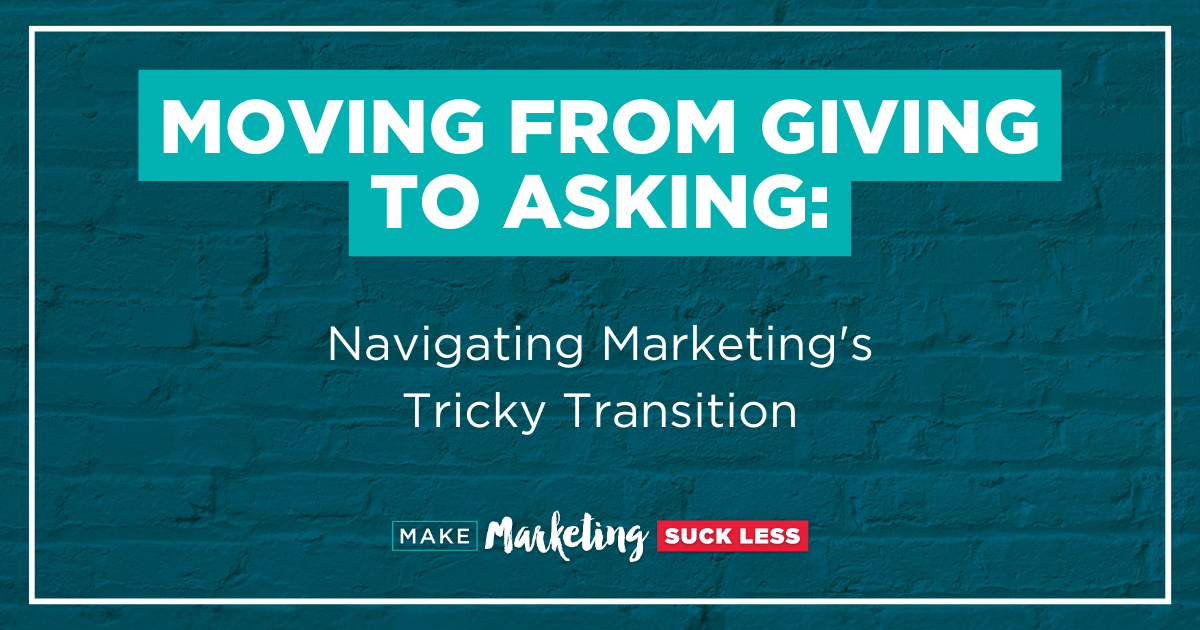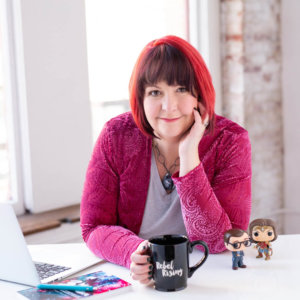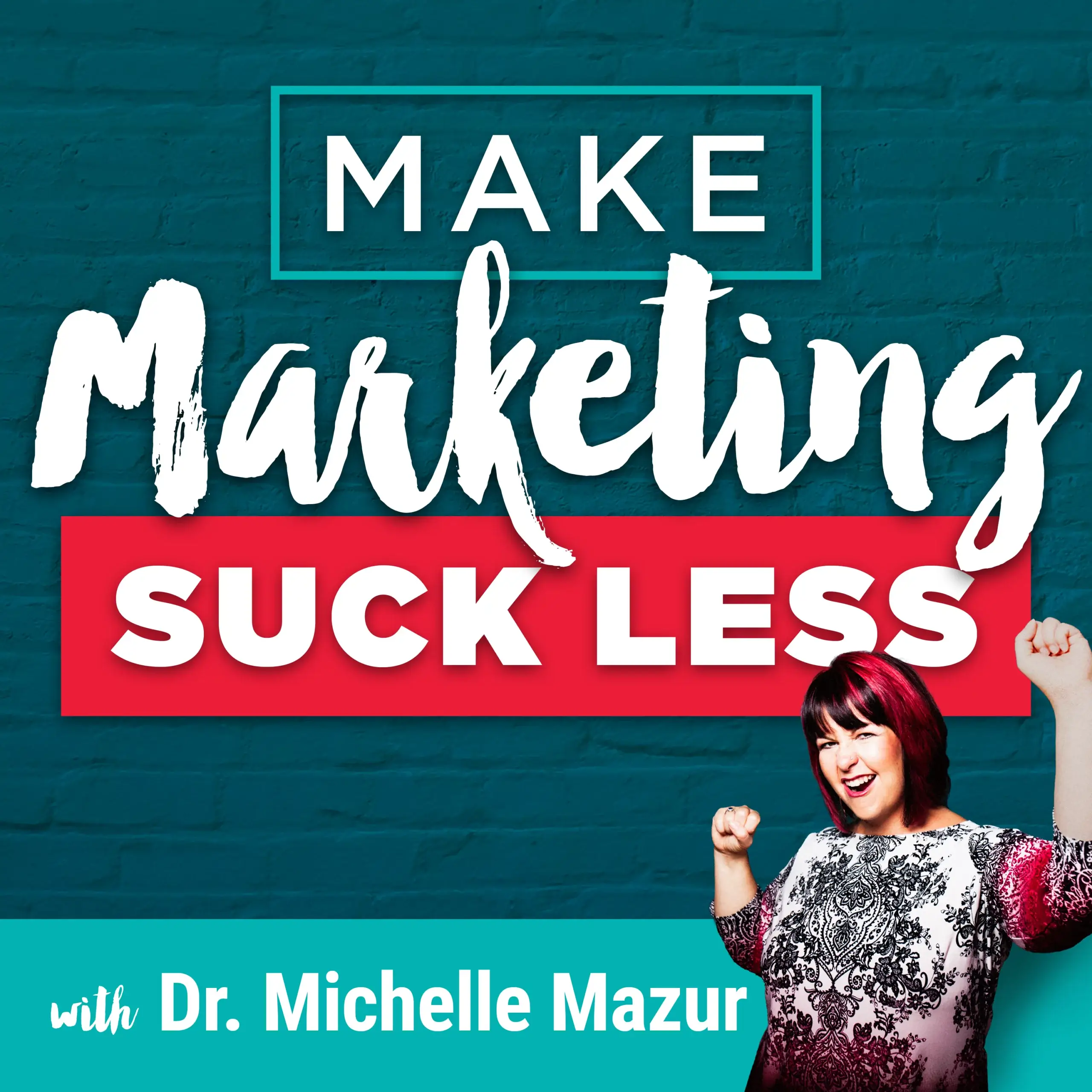Make Marketing Suck Less
Moving From Giving To Asking: Navigating Marketing’s Tricky Transition
By Michelle Mazur > March 5, 2024
Filed Under Podcast

This is gonna get awkward.
There's always a time in marketing when you reach this awkward transition point.
Where you go from empathizing, providing value, and giving your potential clients an “ah-ha” that makes them think to asking them to work with you.
And let's face it. It's a tricky, weird transition to navigate in your marketing.
So, how do you transition from marketing into asking for the sale? That's exactly what we’re talking about.
(Click play or read the transcript below.)
In this episode, we discuss:
- The awkward transition from providing value in marketing to asking potential clients to work with you
- Understanding the mindset shift required when inviting people to work with you
- The rule of reciprocity and why it matters in marketing and sales
- Dispelling major misconceptions about marketing and sales that stops most business owners from making the ask
- The 3 pieces of messaging that make the transition point easier
Learn more about Michelle Mazur:
Resources mentioned:
- Rule of Reciprocity
- Marty Neumeyer
- 3 Word Rebellion Messaging Intensive
- Bev Feldman
- Brittany Herzberg
- Book A Private Tour of The Expert Up Club
Listen on your favorite podcast player or read the Transcript below:
Michelle Mazur [00:00:00]: This is gonna get awkward. There's always a time in marketing where you reach this awkward transition point. Where you go from empathizing, providing value, giving your potential clients an “ah-ha” that makes them think into asking them to work with you. And let's face it. It's a tricky, weird transition to navigate in your marketing. So how do you do it? That's what we're talking about on this episode of the pod. So let's dive in. Michelle Mazur [00:00:46]: Welcome to Make Marketing Suck Less. The podcast that knows marketing is freaking hard, especially when you're a solo business owner trying to juggle it all. I'm your host, Dr. Michelle Mazur, author of the 3 Word Rebellion and founder of the Expert Up Club. Forget the latest marketing fads and tactics promising social media stardom. I'm here with research-backed strategies to help you clarify your message and get twice as effective with your marketing. And while I can't promise you'll ever love marketing, I'm here. to make you hate it a tiny bit less. Michelle Mazur [00:01:26]: Before we dive into how to make that marketing transition easier, I wanted to answer the question about why is it so awkward to invite people to work with us, to invite people who we've been providing value to, who we've been giving them, like, ah-ha moments, why is this so hard, and then I wanna offer you a mindset shift that I had to make that makes this transition a little bit easier. Michelle Mazur [00:02:02]: Why so awkward? Right? If I was to hypothesize, I would say that you are a pretty self aware human being. Most of my clients are and most of the listeners of this podcast are. And we know how it feels in our body to be helpful, to give valuable information, to feel like you're making a difference. Right? That feels good. It feels expansive. You feel like you're helping. Now you've got to ask. And asking is a very different energy, and if you're self aware, you really feel this shift. And it's normal and natural to have that shift in energy, but you have to know how to deal with it. One of the things that really helped me make the shift a little bit more seamlessly and less awkwardly is the rule of reciprocity. And we all know about the golden rule. And here's the deal. When you are providing value to people, when you are helping them in some way, they feel a bit of indebtedness to you, and they feel like they want to give back. Michelle Mazur [00:03:33]: Like, in my business, I've even gotten random gift cards from people because my free content has helped people. They just wanted to give me a little something as a thank you. And humans, we are driven to do this. So if you've been helpful, most of the time, people want to know more about how to hire you, and it is okay to tell them you have earned it. They actually want to know and be invited in to the conversation when it's the right time. But if you're never talking about how to work with you, they can't even budget for you. They can't put it on their radar. So inviting them in and telling them allows them the opportunity to receive the information, and it feels like giving back. Michelle Mazur [00:04:34]: The mindset shift I wanted to provide is because I think there's this misconception that marketing is about helping and sales is about getting. And the thing about sales content or inviting people into your sales process is you can still provide value and be helpful and invite people in. Like, I do this all the time with my email list. It's always this balance of, like, what ah-ha can I give someone? What little nugget can they take into their marketing? Then how can I relate that back to my offer of the Expert Up Club? So when we are in that process of inviting people in to our sales cycle, we are building awareness. People are thinking like, “Oh, I didn't know that was available to me, and now I do. Thank you.” So don't think you're adding less value because you're selling. It is still valuable. Michelle Mazur [00:05:39]: Now let's talk about 3 pieces of messaging that make this transition point easier. We've talked about why it's awkward. We've talked about a mindset shift. But there are some things that you can have in your back pocket as a part of your Minimum Viable Meaningful Marketing Message that make the transition smoother into your call to action. And speaking of call to actions, I wanna be clear about this. At this phase in your marketing, your call to action is going to be an invitation to work with you, whether that is to book a sales conversation, pressing buy on a sales page, or asking for the proposal. So your call to action always should be the 1st step they have to take in order to get in to your sales process. I just wanna put a pin in that because that's where you're leading people to with this type of messaging. Michelle Mazur [00:06:43]: Then the messaging itself supports that person in making a decision or sometimes saying no. Right? That's what you're here for. We're here to help people make a well-informed decision. So the 3 pieces of messaging I wanted to talk about are the Why By Statement, Frameworks and Processes, and Reason To Believe stories. Michelle Mazur [00:07:12]: So let's talk about a Why Buy Statement. A Why Buy Statement is the most compelling reason people should work with you. And I adapted this idea from Marty Neumeyer in his book, ZAG. Part of your Why Buy Statement is promising your potential client something you can actually deliver and blending that with something they want. So here's a couple of examples. one from my 3 Word Rebellion Messaging Intensive, communicate the value your business creates whether you're talking to one person or 1,000,000 people. So that is very clear about what the result's going to be. Like, you are gonna know how to communicate the value of what you do for your clients, whether you're selling 1x 1 services or you're marketing to the masses. Bev Feldman, who is a ConvertKit email marketing automation specialist. One of her Why Buy Statements is “pinpoint exactly where your email marketing tech setup is a hot mess so you can stop missing out on sales.” Right? So you're gonna know how to clean up your act on your email marketing automations so you don't miss out on sales. Right? And the cool thing about this piece of messaging is it makes a very easy transition in to a sales process. Michelle Mazur [00:08:50]: So I use my Why Buy Statement all the time when I’m talking to a potential 1x1 client. I'll simply say, you know, we have our conversation to see if this work is really a fit for them. And then if it is, I can say, alright. The goal of the 3 Word Rebellion Messaging Intensive is to communicate the value your business creates, whether you're talking to 1 person or a 1,000,000. Done. And then I can go right in to the next piece of messaging, which is having a framework or structure. Michelle Mazur [00:09:28]: A framework, a process, a structure outlines the steps for how you work with people in a high level. Now I have probably given the framework for the 3 Word Rebellion on sales conversations at least a 1,000 times by this point in time, but it's always the same. It's like phase 1, we start with our Audience Deep Dive. Phase 2, we do the 3 Word Rebellion work. Then once we've nailed your 3 Word Rebellion, we may move on to phase 3 and create your Client Decision Journey so that we can lead people to your offer. And then finally, we talk Marketing Strategy about how you're gonna get your message out there. Right? Those are the 4 phases. It's structure. Right? Your clients want to know that you have a process, that you have a structure that you will lead them through. And that's because structure breeds trust. Your potential client wants to know that you are going to lead this process. Now I know there might be a few things you're thinking. It's like, Michelle, what do I do? It's so complex. There's so many steps. And this is a place I see experts making mistake all the time. In marketing, you do not need to give everyone all the steps for how you do the thing you do. They don't care. They want to know that you have a structure at a high level. They don't care about all the nuanced details and all the different things you're thinking about or all the theories that inform your work. No. They just wanna know what is my experience like, and they don't need a ton of nuance for it. So it is okay not to include everything, but really just hit the high notes, the hallmarks of your framework, process, or structure. Michelle Mazur [00:11:40]: The other thing I always hear about frameworks and structures is, “but every client is a little bit different.” And, yeah, every client is a little bit different. That's fine. Because when you are in this marketing and sales process, you can have a structure and tell people, “Hey, this is typically what the process looks like. However, it is tailored to your needs. So it might change a little bit because we need to explore different areas. I want to make this custom to you.” Overall, having that framework in place makes it easier to enter into the sales process because people know how you work. It makes it easier in sales conversations or if you're writing copy because you have a structure and you are showing leadership and showing them how they achieve the results that you promise in your Why By Statement. Alright. So that was messaging piece number two. Michelle Mazur [00:12:49]: And then the final piece is the Reason To Believe stories. This is also known as Case Studies, and these case studies highlight your client's transformation. What is possible when people work with you? And I think it's really important to veer off and talk about the two different types of results, the what is most likely to happen, what is typical, and what is possible, because there are typical results that all of our clients can experience from working with us. Right? I've talked about this on the pod before. For me, it can look like they become more confident. They start showing up regularly. People show up to their sales conversations ready to buy for them. Like, those are pretty standard results that I can get for my clients. Michelle Mazur [00:13:40]: But then there's a whole other level of results where my clients have landed book deals or been on the TEDx stage because of the messaging we created. But that's not gonna happen for everyone, but it is a possibility. And I can speak to it, and I can be very clear that those are results that aren't typical. So let's talk about Reason to Belief Studies or Case Studies. One of the things you might ask yourself is, what's the difference between a case study and a testimonial? And when I interviewed Brittany Herzberg for the Make Marketing Suck Less Virtual Event, I love the metaphor she used. By the way, she has a ton of resources for writing case studies, so go check out her website if you're interested in that. So she says a testimonial is a trailer to the movie, whereas a case study is the entire film. It's the whole story. You get to talk about what it was like before they worked with you, what was going on for them. You got to talk about their experience. You get to talk about what the transformation was. So it's really Brittany calls it, you get, like, this try before you buy experience of reading a case study. And right now, in my own business, I am doing case studies for the Expert Up Club because I need those Reason To Believe stories to show people what it's like to be a part of this community because it's a different type of offer, and people kind of choose their own experience based on what their business needs. So being able to show those stories, it's a great marketing asset to invite people into my business. Alright, my friends. So there you have it. That is how you make transitioning from marketing to sales a little less awkward. Please realize that if you've been providing value, if you're helping people, they want to know how you can work with them, how they can hire you to get even more, right, to get more of an experience with you by having your Why Buy Statement, your Framework, your Reason to Believe Stories available, it makes that transition a lot easier because you know exactly what to say. Michelle Mazur [00:16:13]: If the Make Marketing Stuff Less pod is making your marketing more effective so that your clients can find and hire you, please share the show with a friend. The easiest way to do that is through Podlink. You can find the show at pod.link / rebel, and that page will allow anyone you share the show with to subscribe and start listening in their favorite podcast player. That's pod.link/rebel. The make marketing suck less podcast is a production of Communication Rebel. Michelle Mazur [00:16:45]: Our production coordinator is Jessica Gulley Ward. The podcast is edited by Stephen Mills. Our executive producer is me, doctor Michelle Mazer. The make marketing suck less podcast is recorded on the unseated traditional lands of the Coast Salish peoples, specifically the 1st people of Seattle, the Duwamish people, original stewards of the land past and present.
Enter your name and email address below and I'll send you periodic updates about the podcast.
Sign up to receive email updates
Create Your One-of-a-Kind Message
Your 3 Word Rebellion is the Key to Growing Your Business & Impact






